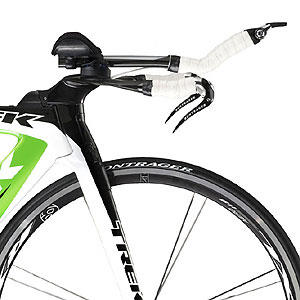
I'll admit it. I was an early fan of S bends. The idea was appealing to me: Give the rider a choke-up position (the pistol grip) along with a fully extended position.
But Steve Hed, the inventor of this bend style, himself withdrew from the S bend as a solution, opting instead for the Lazy S, where the final bend wasn't to horizontal, rather to a shallow upturn.
Few want to ride with a bar with its terminus horizontal. That's just so last year. This means that both S bends and straight bars are out.
What's in? Well, there are two mistakes I see common to bikes ridden by triathletes these days, and, if these mistakes are avoided, then alles ist gut.
Armrest to extension must be planar
In order to get maximum comfort along your armrest, you must lay your forearm down across the entire front-to-back spectrum. For this to happen, the ends of the extension—where your hands hold–must be level, or planar, with the armrest. If not, your forearm will either pivot on the front, or the back, of the armrest, depending on whether the extension terminus is above or below the plane of the armrest.
This is uncomfortable. So, you need to fix this. Happily, most bars these days come with replaceable, or interchangeable, extensions. And most extensions by almost all companies are made in a diameter of 22.2mm. This means you can exchange with a set of extensions made by a company other than the one making your armrests.
And, I frequently do this. But, don't fall in love with an armrest shape without first considering whether that shape is correct for the height of the armrest and clamp system into which the extension will mate.
How do you know if the extension terminus is planar to the armrest? Just lay your arms on the aerobar and grab the extensions. If you feel your forearm comfortably laying along the armrest, equally weighting the armrest front to back, you're there.

Extension terminus should not be horizontal
The bloom is off the rose with straight bars, or S bends that finish horizontal. There are several companies now making extensions that do not terminate in a horizontal plane. My favorite of these feature a low profile armrest, which requires the extension to dip below its original elevation, returning to terminate in an elevation slightly above that of its proximal end.
The first to do this were the extensions designed by John Cobb for Blackwell Products. Blackwell is no longer in business, but the extensions are available through Cobb.
I've now seen a second company make these extensions, during the Tour of California launch of Trek's Speed Concept. These extensions must be made by Bontrager, though I can't find them on Bontrager's website. They're clearly pictured at the bottom of the adjacent image, so, they must exist.
Let's hope that Bontrager produces these extensions for sale along with its aerobars. A better view of these extensions is available on Nick Salazar's fine photo gallery of the Tour of California time trial.
The "descending to upturned" motif, as mentioned above, is an elegant solution to those building aerobars with low-profile armrests. It seems from the photos in Salazar's gallery that Bontrager will be making a lower profile aerobar in the future (based on what it showed during the Speed Concept launch), so the extension they exhibited makes sense. Likewise for any other aerobar company making a low profile aerobar solution.


